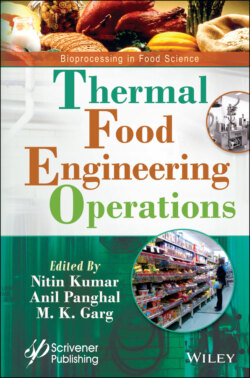Читать книгу Thermal Food Engineering Operations - NITIN KUMAR - Страница 46
2.6 Various Techniques for Thermal Inactivation 2.6.1 Infrared Heating 2.6.1.1 Principle and Mechanism
ОглавлениеInfrared falls in the electromagnetic spectrum fluctuating between 0.78-1000 μm which is between ultraviolet and microwave radiation. Heat is generated due to the motion of the molecules which is both rational and vibrational in nature. Unlike conventional heating where the heating is done by convection at the first from the surface and from inside of the product, it is done by conduction, here infrared offers radiation from outside the surface and conduction from inside of the food product [47]. Numerous studies have been done to verify the anti-microbial effect of IR when applied to various food products such as honey, cheese, milk, fruits, and other liquid and semiliquid products [48, 49]. Infrared works well even for powder products mainly spices and with time varied of the word have also been performed to analyze the effectiveness of the IR treatment for effectiveness in reducing microbial activation. Several factors significantly affect the microbial log reduction but the utmost responsible factor is the temperature and wavelength of infrared radiation. Some of the other factors are as following power, water activity, moisture content, bandwidth, and depth of the food sample [50].
Infrared offers a similar effect of thermal inactivation mechanism as seen in the microwave heating and ultraviolet light which causes DNA damage along with heating through induction and of course. By thermal heating, the inactivation of microorganisms becomes easier; it can destroy or damage different parts of the cell structure which mention in the order of damage magnitude that is protein >RNA >cell wall >DNA. To confirm the effects and study the mechanism of heating for the inactivation of microbes, various methods like fluorescent and spectroscopic probes were utilized for paprika powder performed by [51]. The result inferred from the treatment that radiation of the infrared waves created all-around injury of the cell which includes inactivation of RNA polymerase of the microbial cells, which simultaneously prevents the transferase reaction by combining it with subunits of the ribosome. Much effective and advanced decontamination is visible in this treatment as the waves of the infrared have extended energy levels, and distribution of this energy is very efficient as compared to any other traditional method of heating which mostly uses the fluorescent probe for molecular-level analysis. Analysis using the digital method showed the best results as compared to the conventional one in terms of analyzing the relationship of the targeted organism and the environment they are present in real time.
